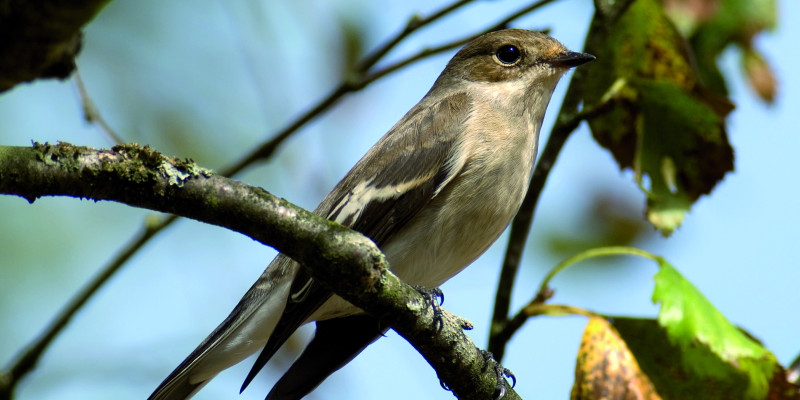BD-I-2: Temperature index for bird species communities
 Click to enlarge
Click to enlargeSource: OhWeh / Wikimedia Commons; CC BY-SA 2.5

2023 Monitoring Report on the German Strategy for Adaptation to Climate Change
 Umweltbundesamt
Umweltbundesamt
 Click to enlarge
Click to enlarge
2023 Monitoring Report on the German Strategy for Adaptation to Climate Change
Climate change entails changes in species communities. In respect of 88 breeding bird species occurring in Germany, the relative frequencies have shifted between 1990 and 2019 in favour of thermophilic species or, putting it another way, shifted to the detriment of cold-tolerant species.
Birds are comparatively sensitive to changes in their environment. This entails that the composition of bird communities can change strongly as a function of environmental impacts. Typically, such changes are the result of various impact factors combined. As a rule, there is no singular cause for a change in species communities and the decline or loss of individual species. There is however evidence from scientific research which indicates that, in addition to changes in land use, climate-related changes can play a crucial role.
Breeding birds require species-specific temperatures at breeding time. These are lower, for instance, in respect of whinchat (Saxicola rubetra), thrush nightingale (Luscinia luscinia) and icterine warbler (Hippolais icterina) than for stonechat (Saxicola rubicola), nightingale (Luscinia megarhynchos) and melodious warbler (Hippolais polyglotta). If, as a result of climate change, temperatures during the breeding season increase in terms of the long-term mean, conditions will become more favourable for thermophilic species which will then become more frequent compared to other bird species. Vice versa, cold-tolerant species are in decline compared to other bird species.
In the period between 1990 and 2019, such a development has been observed in 88 bird species breeding in Germany. As indicated by the temperature index for frequently occurring breeding bird species, the relative frequencies of the birds observed have shifted in this period in favour of thermophilic species or, putting it another way, the relative frequencies shifted to the detriment of cold-tolerant species. From 1994 onwards, the moving 5-year average of the temperature index first shows an increase taking place until approximately 2010, but this was followed by a slightly retrograde development by 2013, whereas this was in turn followed by a distinct increase. However, the development between 2010 and 2013 can be attributed in the first place to effects of weather patterns which had an impact regardless of the long-term climatic trend. In the years 2009 / 2010 to 2012 / 13 there were several consecutive hard winters with adverse effects on many breeding bird populations. The developments since 2013 show that the more long-term positive trend reflected by the indicator has continued despite short-term levelling impacts from a number of hard winters between 2009 and 2013. Nevertheless, it is clear that despite progressive climatic warming, the incidence of extreme weather events is of major importance to ecological change processes.
In various phases of their annual cycle, birds are affected by temperature changes, as for instance during breeding, overwintering or the recruitment of new breeding birds into the population. Consequently, climate change is apt to change the phenology, in other words the life cycle, of species. In particular, bird species overwintering in Africa, south of the Sahara, can suffer detrimental effects from such changes. It is known, for instance, that owing to the earlier beginning of spring, pied flycatchers (Ficedula hypoleuca) sometimes return too late from their winter habitat to exploit the main abundance of caterpillars as food for their young.
For the purpose of calculating the temperature index, a species-specific temperature requirement value is allocated to each of the 88 bird species occurring in their European distribution area, based on the average temperature for the reference period 1961 to 1990. These species-specific temperature requirement values – weighted according to the relative frequency per species in any particular year – are included in calculating the index. The greater the long-term rise in the temperature index of frequently occurring breeding bird species, the stronger the shift in the relative frequencies among thermophilic species and consequently, the stronger the influence of temperature rise on the group of birds under observation. The index values shown refer to Germany nationwide. This demonstrates that it is not possible to make any statements on a changed composition of regional breeding bird communities.
Likewise, other groups of species such as butterflies or vascular plants can be used as indicators for long-term temperature changes related to climate change (cf. Indicators BD-I-3, BD-I-1 and FW-I-1). In this context species shifts become most obvious in ecologically marginal regions such as mountain ranges. For instance, Europe-wide studies of vegetation in the peak areas of mountain ranges above the treeline show that the composition of species communities of vascular plants in those areas is changing. This is where thermophilic species from areas at lower altitude form colonies. Likewise, in rivers, lakes and seas, changes are taking place already regarding the composition of species communities (cf. Indicators FI-I-1 and FI-I-3).
Apart from shifts in the frequency of species within existing species communities, climate change also leads to the immigration and distribution of species which have not occurred in our climes before. These developments take place in respect of both, plants and animals. Examples for this are the melodious warbler (Hippolais polyglotta) which emanates from south-western Europe and became a German breeding bird in the 1980s extending its range ever since, or the praying mantis (Mantis religiosa) which came from the Mediterranean to Germany in the 1990s and is gradually spreading ever more northwards.